The child from two years to two years and eleven months old
To Assess and Celebrate
To assess and celebrate the child from one year to one year and eleven months old;
How was the visit to the followed pregnant women and children? How was the Evaluation and Feedback Meeting? Are there any doubts that can be solved now?
Based on what was seen and sensed, what else would you like to share?
Do you remember any message, prayer or another child song that celebrates this moment?
To See
The child from two years to three years and eleven months old
1- Do the children have a clean and safe place to play together in your community?
2- Why is it important for the children to play together?
3- Do the families try to support and exchange ideas about how to raise and bring up their children?
How the child can learn and grow

Foto:
Do the family members encourage the child to play and do they play with the child?
In this age the child still enjoys always staying with the parents. If he/she stays away from them, he/she misses them very much. Therefore, he/she looks for object that they wear/use and imitates what they do when he/she plays of make believe. The child also begins to wish to do everything alone, including what he/she cannot. The make believe play is important because it allows that the child does playing what he/she cannot do in fact. And, thus, the child starts to learn to acknowledge and to deal with his/her own limits and with the parents’ absence.
To play of make believe, the child still needs of his/her own objects or of toys similar to them. The parents and the family members can make toys for the child such as dolls, small pans, furniture, small cars, and drums. It is also necessary to play with the child, for he/she still enjoys playing a little with the adults.
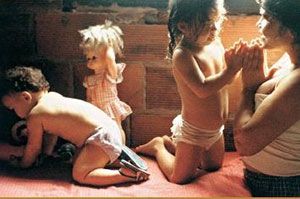
Foto:
In this age, the child asks for the name of everything, for he/she has discovered that each thing has its name. Knowing the name of the things helps he child to think on things that he/she does not see. That is, the child says “ball” and has the idea of what a ball is without needing to see it.
If the family uses to talk to the child and to listen to what he/she wants to say, he/she learns to talk each time better, using phrases with more words such as: Look the beautiful dog, daddy”.
The child can learn small prayers and pray together with the parents at the meals, before sleeping, when waking up. He/she can also learn his/her name, the name of his/her parents and of the siblings.
The child already manages to pay attention for a longer period of time. The parents, the grandparents and uncles can tell stories from the Bible, from magazines; tell cases about someone in the family. These activities interest the child and develop his/her language and thought. The child learns many things from the pictures, from the photographs and looking at written words.
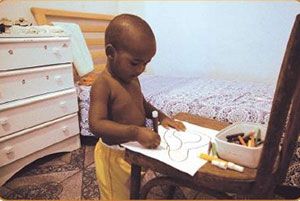
Foto:
The child is already interested in using another type of language: the drawings. He/she discovers that certain materials like pencils, chalk, stone pieces or bricks can make scrabbles on the paper or on the floor. He/she begins to scrabble.
He/she already has the skill to catch and play with smaller things and also remains longer time doing one activity. The parents can give pots and boxes for the child to play, taking the chance to teach about sizes, shapes, colours and to count how many objects there are.
The child does not like that people make fun of him/her when he/she cries, is scared or does not manage to do something. He/she needs to feel that she is understood.
Talking and asking her/him why he/she is sad or happy helps he child to know his/her feelings and also to understand what the other people feel. She continues to enjoy being cuddled, kissed, of staying on the lap of the parents, mainly when another brother or sister is born.
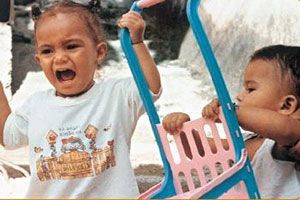
Foto:
The child likes even more to play with other children, but still fights for the toys, for he/she still thinks everything is his/hers. He/she says “it is mine’, to everything and gets angry when he/she does not manage to get what he/she wants. Talking to him/her to try to convince to change this way of acting/attitude is the best way to help the child to accept limits.
The child needs space, for he/she is always moving around. He/she goes up and down from lower things, jumps with the two feet at the same time. She/he also likes to go out with the family, to play in the backyard or in the park with other children.
Attention: It is necessary to watch the child not to go out alone to the street. When the parents go out with him/her, they should hold him/her by the hand, to prevent accidents.

Foto:
Do the people in the family teach the child with no violence what the child cannot do?
The child has already learnt to do many things and now wants to show that he/she has his/her own will. Therefore he/she says “no” almost to everything. His/her favourite answers are: “I do not want”, “I do not go”. He/she is also curious, asks a lot, wants to touch everything and go everywhere. With all this the adults may lose their patience.
But the child needs to know his/her limits and to learn that certain things he/she should not take, for he/she can get hurt, break, or even because they belong to someone else. The adult should explain to him/her, calmly and firmly, but without violence, what he/she can and what he/she cannot do.
The child that learns when he/she gets spanked also learns to spank. The beating is violence and shows that the adult has lost the control of the situation.
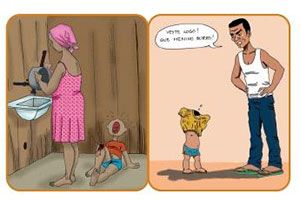
Foto:
Forms of violence are also: Not taking care of the child, not giving him/her attention when the child is crying, not talking to the child and frightening or threatening the child. Badly taken care, sexually abused or spanked children lose their confidence in people, become shy, quiet or aggressive. When the child is raised with violence, he/she learns to live with violence.
The greatest part of aggression against the child takes place at home and is done by people in the family. Many times violence happens because the family is going through a difficult situation; other times, the child gets very naughty because has no opportunity to play or because he/she does not receive much attention.
In each family, in each community, the people have, above all, the obligation to find together, through dialogue, solutions to protect the child from any type of violence. But, in very serious cases, of abuses and bad treatment, the Tutorial Council or any other public service for child protection should be notified.
"Teach your child through conversation, tenderness and support and watch out: for who spanks to teach, is teaching to spank" 4th Commandment for the Peace in the Family.
Food Care
At the meals, the child also wants to show that he/she has his/her own will, choosing what he/she wants to eat. But the parents should encourage the child to eat varied food, and to give the example, eating the same food too. The meals time is to be celebrated. Therefore, it should be a quiet moment without fights/quarrels.
• The child needs to be fed with all types of food;
• Grains such as rice, lentil, beans;
• Pastas , such as bread, macaroni;
• Varied vegetables;
• Fruit;
• Eggs and meats;
• Milk and its by-products (butter, curdled milk, yoghurt), for breakfast and at the snacks time.
Calcium prevents the absorption of iron. Therefore, it is better that the milk and its by-products are not offered to the children at lunch and dinner. Thus, the child can better absorb the iron contained in the meat, in the viscera and other food, such as beans.
The families have more conditions to have a healthy food when they know how to better use the food, without wasting them. Not always what is bought ready made has more nutritious value than the home made food.
Hygiene
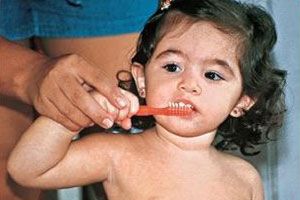
Foto:
In this age, most of the children have all the milk teeth. Now the child can already brush his/her teeth, but always with the help of an adult. He/she can use toothpaste, but in a small amount, for until three years old he/she does not manage to spit all the toothpaste. The excess of toothpaste, when swallowed, can cause problems to the permanent teeth that still are going to appear.
Attention: Keep the toothpaste out of the child´s reach, for there are children that eat the toothpaste tube at once.
During the day, the child can already control the wee and the pooh, but still can wee in bed at night. Therefore, it is good that someone always take the child to wee before going to bed.
Environment
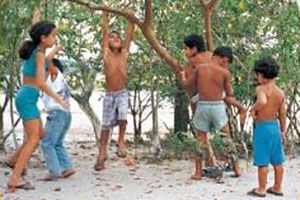
Foto:
The child learns to take care of the environment observing the example from the ones he/she lives with.
When in the community there is improved water, sewer system or proper ditches and the right place to discard the garbage, it is much easier to maintain a healthy environment.
The government also needs to offer clean and safe places, where people can walk, stroll and have leisure. The families have the duty to keep these places in order.
The care with plants and trees helps to keep the air pure and to protect the water springs. To avoid water waste and the burning, are environment care actions and depend as much on the people, as on the public authorities.
Each one can contribute with the environment care. The daily little cares make the world a better place for everyone.
"Praised be You, My Lord, for our sister, mother Earth, which sustains and rules us, and produces diverse fruit and colourful flowers and herbs." St. Francis of Assisi.



